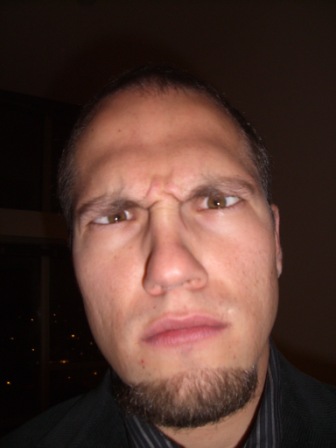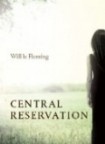Are you looking at me part II
Here’s a contention: some facial expressions do not exist. These are facial expressions we all know. We read them described in books. Occasionally we see actors on TV using them. If we were asked, we would know exactly what the facial expression was supposed to signify. In fact, these expressions are perfect in every way except one: no-one in real life has ever used them.
Image: flickr.com/stevendepolo
So, at this point you are probably feeling sceptical about my claim. I know how that looks. You have one eyebrow arched and your lips are pursed, right? Except, of course, you don’t and they aren’t. Were I trying (lazily) to indicate in a book that a character was feeling as sceptical as you are right now, that is how I would describe it, but it wouldn’t be true. At best I would guess that you have a slight tensing of the face around the eyes. If someone walked into the room right now, I don’t think they would have any idea what you were feeling until you started to articulate it in words.
The expression that really seems to typify this is the frown. Dead easy. Everyone knows that one, even children (who are, I think, the only people who actually frown. Them and the adults looking at them, deliberately pulling a childish face). So: if I write in a book that a character is frowning, you know perfectly well that this character is feeling disapproval.
My problem is that I don’t think people actually frown disapprovingly. I think people only frown when they don’t quite get something: when they are feeling troubled or confused. Those kinds of frown exist. But the angry frown is a phantom gesture. We have all decided we would like a kind of visual short-hand or code for when people are feeling angry and disapproving. We have all agreed it will be a frown. This word, this hypothetical expression, now circulates like currency. It can be tendered in books and on TV. Each side understands the value of the currency, each side is satisfied with the transaction. But if you actually tried to redeem this currency against genuine expressions in reality, I don’t think you would find a match.
Image: flickr.com/chispita_666
Now, at this point I know that many of you may have progressed from scepticism to outright rejection of this idea. I asked around a bit before posting this, and some people thought I had a point, others that it was all nonsense, and a third group seemed to be listening, nodded slowly and then said yes when the question was not a yes-no question (which is something that does happen a lot in real life and not very often in books).
However, here is my clincher, my absolute proof that we have developed a system of fake expressions to convey meaning. Let’s leave the frown aside (though if you have views on that, please do comment). Let’s look instead at the jaw-clench.
This one you’ll know. Recall the last time you watched an average actor in a film or on TV. They are in close-up. The conversation/situation is tense. How do they convey this to us? All of them, to a man and woman, do the same thing: they clench their jaw a little, then relax it again.
Once you realise that this is the Great Secret of All TV and Film Acting, you can’t help noticing it. It happens all the bloody time. I still remember the moment in the Harry Potter films when someone had evidently taken pity on the three leads, finding their performances comically wooden, and initiated them into the Secret Order of the Jaw-Clench. About film three, they all started doing it. Close-up? Tense? Bite down!
From that day on, our three leads remained every bit as charmingly wooden as ever, but with the one trusty tool of screen acting in their armoury. By film seven their jaws were pulsing and bulging all over the place, to the extent that when they shared screen time with actual actors, like Alan Rickman, I’m amazed he could concentrate. He could, though, and in all situations, even the most extreme, such as meeting his own death, he used actual expressions. The ones we use in real life. There was sometimes a tension around the eyes. There were small twitches and curls of the lips. There was very little movement going on, but profound emotion was communicated.
That works on screen, though only a handful of actors have mastered it. Trouble is, what do we do in books? We have to describe expression, but can we really kick against the code, and describe what people’s faces actually do, in the minute level of detail that would be required? Or should we accept that the short-hand exists, and use it, knowing that we are connecting the idea in our heads with the desired idea in our readers, even if reality is bypassed?
I don’t know the answer to this. And that means, I’m sure, that you know how I look as I type. I’m pensive, right? Quizzical. I’m frowning. I’m probably tapping a pen reflectively against my teeth, or biting my lip. Right? Guys? Right?


 Will le Fleming is a novelist. His debut, Central Reservation, is published by Xelsion and
Will le Fleming is a novelist. His debut, Central Reservation, is published by Xelsion and 


I completely agree
I do understand the difficuty in describing, in a meaningful and unclichèd way, facial expressions – and indeed, I think there is some webpage out there somewhere, listing a series of descriptors for writers to use (someone pointed me to it once, I meant to bookmark it, honest). However, I disagree that facial expression doesn’t really exist as commonly described. I’d recommend reading Charles Darwin’s ‘The Expression of the Emotions in Man and Animals’. It shows that not only do we have common, cross-cultural, expressions, but also they are sometimes shared by (other) animals too. Someone (Houseman?) once wrote that hidden in the heart of each cliche is a garnet of truth. Clichès – of expression not the least – can be true.
But anyway, I like the post and the site!
Interesting: and I absolutely agree that many facial expressions are real and unite us. Just not convinced by all of them as described! And agree too about cliches. I think the truth of them makes them very valuable, on occasion, as short-cuts: because the phrase is familiar, the listener understands its meaning even before the speaker has finished saying the words, so it speeds up communication. I guess in most writing though I am looking for long-cuts, not short-cuts: the scenic and unfamiliar route to a familiar truth…